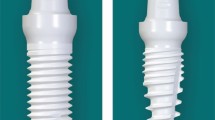Abstract
Design This study is a monocentre cohort study with a primary aim to assess the five-year survival of alumina-toughened zirconia (ATZ) implants (Metoxit AG, Thayngen, Switzerland). Secondary aims were to evaluate peri-implant marginal bone loss (MBL), soft tissue health and patient-reported outcome measures (PROMs). The implants were placed into healed ridges and, following a period of temporisation, were restored with either IPS e.max CAD LT or IPS e.max ZirCAD veneered with IPS e.max ZirPress (Ivoclar Vivadent, Schaan, Liechtenstein). Patients were followed up at prosthetic delivery, one-year and five-years post-implant placement. The clinical parameters recorded were clinical attachment levels (CAL), probing depth (PD), gingival recession (GR), modified bleeding index (mBI) and modified plaque index (mPI). MBL was evaluated using standardised radiographs. PROMs were used to assess patients' satisfaction utilising a visual analogue scale (VAS) to rate function, aesthetics, sense, speech and self-esteem. The null hypothesis assumed there was no difference in implant survival between one and five years post-operatively. This study was approved by the ethics committee at the University of Freigburg, Germany (No. 354/07).
Cohort selection Forty patients from the Department of Prosthetic Dentistry requiring either an implant supported single crown or a three-unit implant-supported bridge were included in the study. Patients ranged from age 18 to 70 and were selected on a 'convenience basis'. Inclusion criteria stipulated patients must have good oral hygiene, compliance and be systemically healthy. Additionally, they were to have a stable occlusion, no signs of significant bruxism and sufficient bone volume to allow implant placement without the need for larger augmentative procedures.
Data analysis Implant success was defined by three main criteria: (1) no local or systemic reactions; (2) no signs of radiolucency on an intraoral radiograph; and (3) provides support to a functional restoration. The MBL was classified as successful when at a one-year follow-up, implants demonstrating no clinical or radiographic signs of pathology are assigned a grade I success with <2 mm of MBL or grade II with <3 mm of MBL. Data analysis was performed by a single independent member of the university using 'xtmixed' on the software STATA 16.1 (StataCorp LT, College Station, TX, USA). This utilised linear mixed models with random intercepts to assess the impact of time, the type of restoration (single crown or bridge) and the location of the implant (either being adjacent to a natural tooth or an implant) on the peri-implant soft tissues, bone and PROMs. The Scheffé test was utilised to allow multiple pairwise comparisons and the level of significance was set at 0.05.
Results Of the 40 patients, 27 received a single implant for restoration with an implant crown and 13 patients received two implants for restoration with a three-unit bridge. This totalled 53 implant placements, 18 in the maxilla and 35 in the mandible. Three of the 27 patients who received a single implant experienced early failure, before definitive restoration. Of the 37 patients who had their implants restored, two patients each with a single implant were lost to follow-up between one and five years, one deceased and one relocated. The five-year survival was 94.3% with all failures occurring before definitive restoration. The null hypothesis could not be rejected, with the study demonstrating no difference in ATZ implant survival rates between the one- and five-year follow-up. An MBL of 0.71 mm was seen from implant placement to definitive restoration, a statistically significant difference (p <0.001). The MBL at one- and five-year follow-up demonstrated no significant difference, with 0.78 mm and 0.81 mm of MBL, respectively. Greater MBL was found with the three-unit implant bridges compared to the single implant crowns and no other factors were found to be significant. Regarding the peri-implant soft tissues between prosthetic delivery and five-year follow-up, there was a significant increase in the PD, mPI and mBI (p <0.001) but no significant difference in the CAL and GR. Although the mPI increased, they assure us the oral hygiene of the patients was still 'regarded as good' and the increase may be attributable to the crown design. All PROMs showed a significant average improvement from baseline to definitive restoration and over the course of the five-year follow-up, patients' perceptions of aesthetics and sense increased further.
Conclusions ATZ implants placed in this select cohort of patients show good performance over a five-year follow-up with respect to survival, MBL, soft tissue health and PROMs.
This is a preview of subscription content, access via your institution
Access options
Subscribe to this journal
Receive 4 print issues and online access
$259.00 per year
only $64.75 per issue
Buy this article
- Purchase on Springer Link
- Instant access to full article PDF
Prices may be subject to local taxes which are calculated during checkout
Similar content being viewed by others
References
Östman P, Hellman M, Albrektsson T, Sennerby L. Direct loading of Nobel Direct and Nobel Perfect one-piece implants: a 1-year prospective clinical and radiographic study. Clin Oral Implants Res 2007; 18: 409-418.
Roehling S, Schlegel K, Woelfler H, Gahlert M. Performance and outcome of zirconia dental implants in clinical studies: A meta-analysis. Clin Oral Implants Res 2018; 29: 135-153.
Papaspyridakos P, Chen C, Singh M, Weber H, Gallucci G. Success criteria in implant dentistry: a systematic review. J Dent Res 2011; 91: 242-248.
Howe M, Keys W, Richards D. Long-term (10-year) dental implant survival: A systematic review and sensitivity meta-analysis. J Dent 2019; 84: 9-21.
Chrcanovic B, Albrektsson T, Wennerberg A. Smoking and dental implants: A systematic review and meta-analysis. J Dent 2015; 43: 487-498.
Buser D, Ingimarsson S, Dula K, Lussi A, Hirt H, Belser U. Long-term stability of osseointegrated implants in augmented bone: a 5-year prospective study in partially edentulous patients. Int J Periodontics Restorative Dent 2002; 22: 109-117.
Wittneben J, Millen C, Brägger U. Clinical performance of screw-versus cement-retained fixed implant-supported reconstructions - a systematic review. Int J Oral Maxillofac Implants 2014; 29(Suppl): 84-98.
Author information
Authors and Affiliations
Rights and permissions
About this article
Cite this article
Bradley, H., Owen, B. & Keys, W. Zirconia implants: a promising alternative to titanium?. Evid Based Dent 22, 102–103 (2021). https://doi.org/10.1038/s41432-021-0202-2
Published:
Issue Date:
DOI: https://doi.org/10.1038/s41432-021-0202-2



